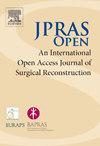Long-term results of lymphedema treatment with Combined lymph node transfer and collagen scaffolds: An Observational Study
IF 1.5
Q3 SURGERY
引用次数: 0
Abstract
Aim
Vascularized lymph node transfer (VLNT) accelerates growth factor secretion, lymphatic endothelial cell migration toward the interstitial flow and lymphagiogenesis in a multidirectional pattern. Our observational study aimed to examine the hypothesis that nanofibrillar collagen scaffolds (NCS) combined with VLNT can provide guided lymphagiogenesis creating long-lasting lymphatic pathways.
Methods
Twenty-four patients (21 female, 3 male) underwent a lymphatic microsurgery for upper (n = 11) or lower (n = 13) limb secondary lymphedema and completed at least 18 months follow-up were selected and equally divided in 2 groups; Group-A underwent VLNT, Group-B underwent combined VLNT and NCS procedure. Lymph node flap sizes, harvesting procedure, and implantation location were similar in both groups. Demographics, lymphedema etiology and staging, limb volumetry, and somatometric data were recorded. Pre- and post-operative data for limb-volume difference, infection episodes/year, and indocyanine-green (ICG) lymphography changes were documented in all patients.
Results
Mean follow-up was period was 42 months (24–60 months) in Group-A, and 27 months (18–48 months) in Group-B patients. Demographic data, lymphedema etiology, and staging were comparable in both groups. Pre- and post-operative edema volume difference for Group-A was 36 % and 25 % (p < 0.001), and 33 % and 14 % in Group-B (p = 0.001), respectively. The mean number of infection episodes decreased in Group-A and B from 1.75 to 0.33 and from 2.17 to 0.42 per patient/year, respectively. ICG mean stage in Group-A was 3.58 pre- and 3 post-operatively (p = 0.045), and 3.67 pre- and 2.08 post-operatively in Group-B (p = 0.506). A statistically significant difference was found in post-operative volume difference between the 2 groups (p = 0.008) and post-operative ICG changes (p < 0.001). ICG-lymphography demonstrated new lymphatic vessel formation at the NCS implantation location.
Conclusions
Long-term follow-up of the patients treated using combined VLNT-NCS approach revealed a statistically significant improvement regarding volume reduction, infection episodes per year, ICG downstaging, and new lymphatic vessel formation, compared to VLNT alone.
求助全文
约1分钟内获得全文
求助全文
来源期刊

JPRAS Open
Medicine-Surgery
CiteScore
1.60
自引率
0.00%
发文量
89
审稿时长
22 weeks
期刊介绍:
JPRAS Open is an international, open access journal dedicated to publishing case reports, short communications, and full-length articles. JPRAS Open will provide the most current source of information and references in plastic, reconstructive & aesthetic surgery. The Journal is based on the continued need to improve surgical care by providing highlights in general reconstructive surgery; cleft lip, palate and craniofacial surgery; head and neck surgery; skin cancer; breast surgery; hand surgery; lower limb trauma; burns; and aesthetic surgery. The Journal will provide authors with fast publication times.
 求助内容:
求助内容: 应助结果提醒方式:
应助结果提醒方式:


